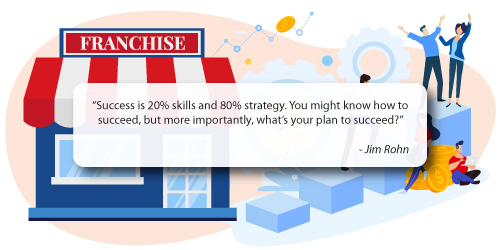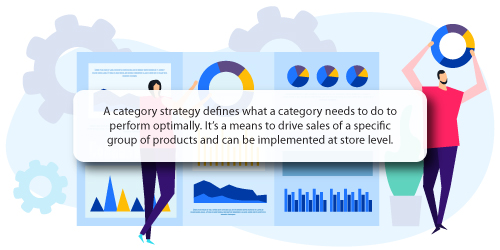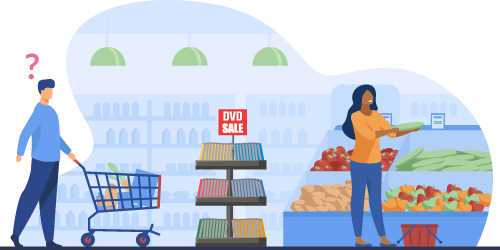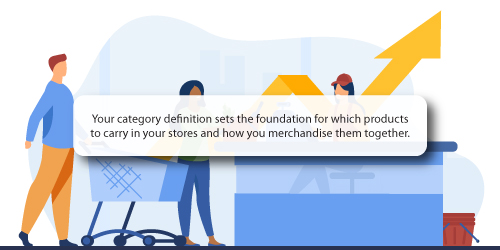Do you want to win at retail? Then listen up: all you need to do is please your customers, which leads to increased sales and profit. Simple, right? We'd be lying if we said it was. But we'd like to add this: it might not be easy, but if you implement a suitable category strategy and its respected tactics correctly, you can be confident that you'll see success.

So what goes into such a category management strategy? What details do you need to include, and what do you not need? What is its purpose? You'll find all of the answers below, including why you must have one in the first place.

What is a category strategy?
Before we dive into what goes into the development of an effective and robust category strategy, it's worth taking a step back. If only to better understand what we mean when we say 'category strategy'.

The category role you choose also defines your strategy. It is the role your category takes on within your stores. There are four primary category roles available to you:
- Destination: By choosing this role, you want to present yourself as the primary category provider and store of choice for shoppers.
- Seasonal: You can use this role to differentiate yourself from your competition during specific periods throughout the year.
- Routine: By choosing this role, you want to show shoppers that you can provide consistent and competitive value for their everyday needs while also presenting yourself as one of the preferred category providers.
- Convenience: This category aims to guarantee one-stop shopping and plays a critical role in margin enhancement.
Let's say you are a large chain pharmacy retailer and want to become the store of choice for Hair products. You'd thus give your Hair category a Destination role. You'd also need to choose the correct tactics.
We’ll cover the different category tactics in more detail in this piece. For now, it’s worth mentioning that you should apply your tactics to your category to ensure they meet the requirements of your chosen role.
For example, you may be the sole retailer of an international coffee brand. That could force customers to only shop your store for that brand, which means it takes on a Destination role.

What should you following a category strategy?
If following a category strategy means you can please your customers and increase your bottom line, the consequences of not following one are self-evident.
- Fewer customers; and
- A drop in sales
There is also the long-term damage that an unsatisfied customer can have on your business.
That said, it's not so much about following any category management strategy as it is about pursuing the correct one. You can have the best plan, which places you ahead of your competition. You can execute it flawlessly. But it means nothing if you don't align it with the role that you are attempting to fulfill.
Let's say you run a handful of grocery stores and choose to stock DVDs in all of them. There's nothing wrong with that if you follow a Transaction-building strategy that aims to increase basket size. It's a problem when you choose a traffic-building strategy for the category that holds these items.

Shoppers are not visiting your store to buy DVDs. You’re a destination store for fruit and vegetables. That means when you set up your initial strategy, you did so without deciding on an appropriate role.
Alongside that, you’ll have executed the wrong product assortment strategy. As a result, you’ve wasted your money buying a large variety and quantity. You’ll sit with hundreds of unsold DVDs. Also, your expected ROI will be non-existent, and you’ll have to write off that stock.
That is only one example. However, imagine if you make the same mistake for other categories in your stores. You’ll soon face the problem of having too much of your capital caught up in inventory you can’t sell.

What goes into a winning category strategy?
1. Decide on your category definition and role
Before you can think about creating your category strategy, you must first decide on the definition of each category.

The planning that goes into this grouping of products determines whether or not the shopping experience for your customer is comfortable and easy.
Category definition
When deciding on your category definition, you must base it on your consumer decision tree (CDT).
Your CDT shows you how your shoppers prioritize when deciding what to buy. For example, when purchasing ice cream, will your customers choose based on flavor, brand, or packaging size?
Along with that, your CDT shows you the relative importance of your product attributes. Another important aspect is that there should be a level in your product hierarchy on which your products can be interchangeable.
Let's use ice cream cones as an example here. If a specific brand or flavor is out of stock, your customer will buy another brand rather than not buy any ice cream at all.
Category role
With your category definition chosen, it's time to decide the role.
Your category role determines the depth of the range you carry. As mentioned above, there are four primary roles from which you can choose. The role you select also establishes its purpose, so you must choose wisely.
If you're struggling to decide on a role for a category, then ask yourself this:
- Why is this group of products in your store?
As much as you want to stock a category, is it worth it if it doesn't make sense to your customers?
2. Analyse all possible data
With your category definition and role set, the next step is to analyze all possible data.
It's the third step of the six that make up the category management process. Known as Insight Generation, it involves an in-depth analysis of your market, consumers, and chosen strategies.
Market assessment
This assessment is only possible if you purchase market data (often costly) or can access it via other means such as through your suppliers, who know and understand the market in context.
With market data, you can understand your performance versus your competitor and where to improve. It also allows you to identify trends and any potential opportunities and threats.
Consumer assessment
The second assessment focuses on the consumer. Fortunately, gathering this information is easy since it comes directly from your point of purchase or till area.
This data also allows you to understand buying habits and shopping behavior. By analyzing your sales and unit data over 6 to 12 months, you can know what to stock and when.
A bonus is that you can also use the information you gather to allocate space accordingly for each category.
For example, if a specific sub-category, brand, or segment generates 80% of your overall sales, you can give it proportionally accurate space allocation based on those sales. As a side note, when determining the correct category space allocation, you must consider more than your overall sales contribution.
Category strategy assessment
The third assessment is to look at your categories. Here, you want to look for opportunities within your product groups from a few perspectives, including:
- Pricing;
- Product Assortment;
- Placement; and
- Promotion.
The objective is to understand if you should continue with the present category categorization, which categories require additional effort to generate more profit, and which areas offer the highest turnover and return on investment.
By gathering, analyzing, and understanding your data, you’ll have a guide for better decision-making.
3. Match your chosen strategy with appropriate tactics
The strategy you choose depends on the type of products within the category. Once in place, it’s all about finding a tactic to match.
In brief, there are six primary category strategies:
- Traffic Building;
- Transaction Building;
- Profit Generating;
- Turf Defending;
- Excitement-creating; and
- Image Enhancing.
Similar to your category roles, you can have multiple strategies in your store. You'd need a different one for each category while also having one to tie them all together.
Let’s say, for example, you run a chain of medium-sized supermarkets and you stock toothbrushes. In such a scenario where customers purchase this product regularly, you’d consider taking on a Routine category role. As part of that role, you’d want to stock 70% to 80% of the range to please your customers.

In this instance, a good category strategy to follow would be Traffic Building.
Since tactics revolve around your pricing, the placement of your products, product assortment, and promotion, you want to match that to a traffic-building strategy.
In this case, a good product assortment tactic would be to focus on the top 10 products within your category. But be careful: you must also consider your overall target when deciding your strategy and tactic. If you want to increase your turnover, Traffic Building is a good strategy.
On the other hand, if you want to increase customer loyalty, a traffic-building strategy wouldn’t give you your desired outcome.
4. Implement
With everything in place, it's time to see if all your hard work has been worth it.
But how do you implement your strategy? That's where a holistic and robust category management solution can help you.
Assortment planning
On the one hand, you will get an assortment planning tool that can help determine the right product assortment for your target market. Since your product assortment feeds into your category role and your category role determines your range, you must have a firm hold of it.
Space planning
On the other hand, you'd get access to a space planning tool, which can help you present your customers with logical and shopper-friendly product layouts.
Mind you, it's not just about what is on the shelf (micro space planning) but also how you lay out your store (macro space planning/floor planning). Furthermore, such a tool can also help you to implement any promotion tactics as you can display your products in a way that catches the eye of anyone in your store.
Retail data
Then there is the fact that category management is data-intensive. All of your retail data must talk to each other. With all the valuable information about your space planning efforts available in a powerful retail analytics tool, you can understand how your retail space is performing and where to tweak it where necessary.
Conclusion
If you read everything above, we don’t have to point it out. However, we’re going to, even if it is only to reiterate its importance: a category strategy is nothing without correct implementation. Likewise, you can't implement a strategy correctly without first having one. Or expect to see results when you’ve chosen the wrong one.
Are you interested in a category management solution that can help you implement your strategy and meet your goals? Why not book a custom exploratory consultation with a DotActiv expert here? We can help you, no matter what challenges you face.


